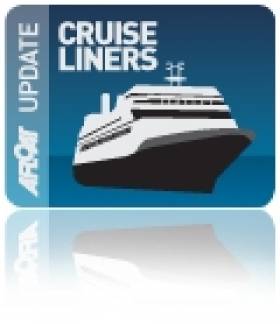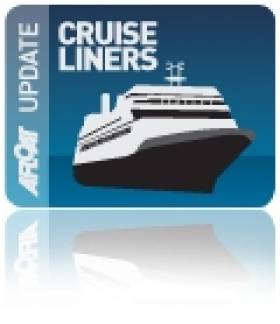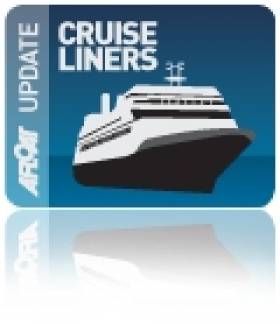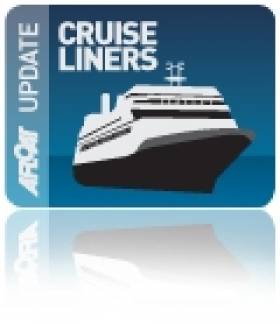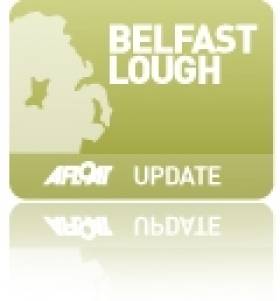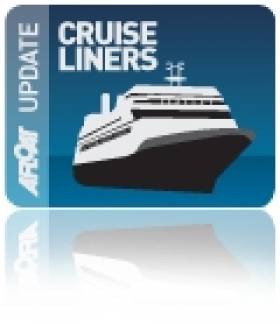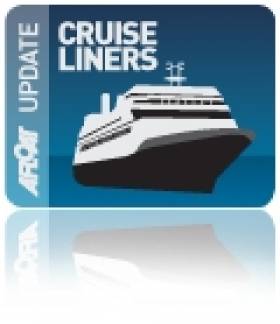Displaying items by tag: Cruise Liners
#Semester@Sea – Students from the University of Virginia, USA are on a 66-day long Semester at Sea voyage on board the Explorer, which is to dock in Dublin Port this morning, and where she will stay for the next five days, writes Jehan Ashmore.
The 'floating campus' that is of the 24,000 tonnes Explorer which was built as a cruiseship in 2001 had sailed from Greenock overnight.
The Semester at Sea programme of the Institute for Shipboard Education, is sponsored by the University of Virginia. Founded by Thomas Jefferson in 1819, the university is one of the USA's most prestigious institutions of higher education.
Twice a year she circumnavigates the world and explores a region each summer. On this 2014 voyage, 11 cities and 10 countries in northern Europe form the Semester at Sea programme which set sail last month from Southampton in the UK and having also called to Bilbao and Lisbon.
So what facilities are to be found on ship serving some 2000 students annually and to meet their educational and residential requirements? Asides the obvious need for 'classrooms' click HERE, there is a 9,000-volume library, computer laboratory, wireless-internet access, and a student's union venue in addition to many of the amenities you'd expect on a land-based campus.
Students have a unique opportunity during the Semester at Sea to engage in global comparative education.
On each voyage, a set of Global Comparative Lens courses are designed to help students deepen their understanding of specific features of life and culture in the countries of the voyage itinerary.
Among the lens offerings is a field study visit tomorrow of the Hill of Tara and Bru na Boinne Visitor Cente, which forms part of the course, Foundational Religions of Europe: From Odin to Allah.
Following her Irish call, the semester sails to Scandinavian and Baltic ports, among them St. Petersburg. The voyage will also include a transit of the Kiel Canal and a stopover to the Polish city of Gdansk before returning to the UK next month.
Sixties Sun-Seeker Still Rocks During Dublin Debut
#ClassicLinerLady – Louis Aura a classic cruiseship dating almost fifty years having been launched in the late 60's made her debut call to Dublin Port today, a first for Cypriot operator Louis Cruises, writes Jehan Ashmore.
Her call follows Belfast yesterday as previously reported, and her visit represents a new cruising region which otherwise is the eastern Mediterranean from Cyprus, Greece and Turkey.
Louis Cruises was founded in 1986 and was added to the Limassol based Louis Group which has operated since 1935. The operator runs Louis Aura on short cruises from Cyprus and her fleetmates, Louis Crystal and Louis Olympia this season offering 4 to 7 days cruises from Greece and Turkey.
The veteran 16,000 tonnes was launched in 1968, though she had a major refit in 2005 to increase her lifespan. Only last year she was renamed having been Orient Queen and before that Bolero. This follows a career first starting as Starward which was geared for the U.S. market running under Norwegian Caribbean Lines.
Her cruising grounds of the balmy Caribbean embraced a design to reflect her environment where a three-deck high sun-lounge which is partially enclosed is sited above the bridge.During service for NCI this popular spot named the Tropicana Garden with its 'Skybars' next to the adjoining sheltered lido-area would became particular hot due to such humid conditions.
Here a spiral staircase links two decks which overlook the aft swimming pool again partially sheltered by the glazed screen walls of this feature which was ahead of its time. Fortunately these bars remain to quench a thirst while overlooking the Hera Deck below with its swimming pool.
For further details included photo of facilities for more than 800 cruise-goers, plus views of staterooms and corresponding deck plans, take a peek by clicking this LINK.
In addition the open promenade deck with lifeboats is a refreshing feature which is an increasingly unique feature compare to modern cruiseships which also lack cruiser-sterns, having said that the added superstructure somewhat spoils the aft deck. While at the opposite 'end' of the vessel at the bow is where a former cargo-hold along with derricks is now where a heli-pad is located.
Despite these changes, she still retains exterior styling by Knud E. Hansen of Copenhagen, from where her Scandinavian ferry origins included a vehicle deck to carry freight-trailers between Miami, the Bahamas and Jamaica.
This ability to carry vehicles has long since gone and was never a feature of her pure cruise sister. Skyward which too was commissioned by NCL from the yard of AG Weser Seebeckwerft in Bremen.
Her stylised twin funnel uptakes are particularly streamlined and positioned further aft to accentuate a slick profile superstructure.
This evening she is due to depart at 20.00hrs having spent a stunningly sunny day under Irish climes! It is understood her next port of call is Portsmouth.
Stylish Sixties Classic Becomes Newcomer to Belfast Harbour
#CruiseClassic – Belfast Harbour welcomed Louis Aura (1968/16,781grt) on her first visit to the port yesterday having cruised in Scottish waters, the caller been the first of three new visitors due this season to the port, writes Jehan Ashmore.
Louis Aura is operated by Cypriot based Louis Cruises which normally operate services in the eastern Mediterranean throughout the Aegean Islands, Turkey and Cyprus.
Only last year the veteran vessel was renamed for further service in a career that stretches almost five decades ago. The former Orient Queen underwent a major refit in 2005 to extend the vessel's prospects that originally stemmed from serving service in the Caribbean. This involved Miami-Bahamas and Jamaica. She would later become Bolero for service elsewhere.
Launched as the Starwind, she followed predecessor and trendsetter Sunward ordered for Norwegian Caribbean Line to serve the U.S. market in which her '60's styling in terms of exterior is clearly evident of that era.
Note the glazed three-deck wraparound sun lounge feature above the bridge. This is where the Panoramic and Zeus Decks form double bar areas overlooking the sheltered sun-bathing area and swimming pool on Hera Deck (as above click link for aerial photo). Such a feature leads to the streamlined twin funnel uptakes that sweep along the profile forming a rather aerodynamic superstructure.
Together they were pioneering in design from the distinctive hand of Danish naval architects Knud E. Hansen A/S. notably world renowned for their cruiseships and car-ferries.
The call of Louis Cruises to Belfast is a boost for the cruise sector visiting Northern Ireland and of subsequent newcomers due this season, Berlin and Club Med 2.
Overnight Louise Aura departed Stormont Wharf and arrived into Dublin Port this morning on what was also her debut call to the capital. She berthed in Alexandra Basin, where Fred Olsen Cruise Lines Black Watch which too had called from Belfast had previously made a mid-week call.
Bantry Bay Cruise Scene: A Setting for A Sapphire
#BantryCruiseships – As previously reported, Serenissima (1960/2,598grt) a 110 passenger exploration cruiseship which called to Glengariff mid-week was yesterday followed by Saga Sapphire to the secluded west Cork anchorage, writes Jehan Ashmore.
Operated by Serenissima Cruises, she reflects a different era with classically designed hull forms and overall appearance of an era that remains with the Hurtigruten final traditional ship, Lofoten which celebrates her 50th anniversary this year.
Saga Sapphire (1981/37,301grt) with a 710 passenger capacity is easily the largest cruise ship caller this season to call to Bantry Bay. Operated by Saga Cruises, she had sailed from Killybegs, having also visited Belfast and Dublin.
She is the third caller this season out a total of six to visit Bantry Bay Port which at the turn of this year, saw responsibility for the control of Bantry Bay Harbour transferred to the Port of Cork Company.
The transfer order was made by Minister for Transport, Leo Varadkar TD, and for the purposes of managing operations in Bantry Bay, the Port of Cork Company established a subsidiary company, Bantry Bay Port Company Limited.
To date, Le Boreal and Minerva have called in late May opening the cruise ship season which will also see Amadea call in August make a repeat visit in October to mark the end of the season.
As for the interim fifth visitor to call to Glengariff, Club Med 2 is to make an appearance in September, her 'tallship' presence will further add to the allure of cruising is such a scenic setting.
As there are no berthing facilities to cater for cruiseships alongside charming Glengariff, this all lends to the experience of anchoring in the surrounds of beautiful Bantry Bay.
Nearby is Garnish Island, where many visitors take the small ferry service to the island, where the world renowned gardens are laid out with specimen plants that are rare in this climate.
Serene Cruiseship Caller to Glengariff as Classic Racing Boat Prepares for ICRA Nationals
#CruiseSailing – As Serenissima departed scenic Glengarriff, west Cork yesterday evening, the exploration cruiseship shares connections with Soufriere, an entrant in today's start of the three-day ICRA Nationals held off Dun Laoghaire Harbour, writes Jehan Ashmore.
As W.M. Nixon drew our attention in his Saturday Sailing column of the Spirit 54 sailing classic, Soufriere, she will clearly have a racier sporting presence among the 100 plus ICRA fleet but also the added allure of her debut appearance in a James Bond film.
It was that scene in 'Casino Royale' which saw Daniel Craig as 007 and his co-star Eva Green at the helm along the Venetian waterway of the Canal Grand.
The glamorous pairing of the silver screen stars set in the jewel of Venice, is from where the name of the cruiseship operator, Serenissima Cruises, that takes its name from 'La Serenissima'. The title given to the 'Repubblica di Venezi' that existed until 1797 and which literally translates to 'the most' or 'very serene'.
Such a description is easily applicable to the Italian city on the Adriatic and the same could be said for those sweeping lines of the cruiseship and that of the stylish yacht-racing boat.
So when Stephen O'Flaherty's Soufriere gathers Dublin Bay wind in her sails, having departed the ICRA Nationals host of the Royal Irish YC, the harbour of Dun Laoghaire is also where as previously reported the Serenissima (photo) too made a visit last summer. For footage of her underway off Sandbanks, Poole Harbour click HERE.
To continue on the theme of royalty, on the same day of Serenissina's debut call, Cunard's flagship, Queen Mary 2 also made her inaugural visit while anchored offshore.
Record Trading As Profits Soar At Belfast Harbour
#Belfast - Belfast Harbour is reporting a profit of £26 million (€32 million) in 2013, a whopping 42% rise on the previous year.
The Belfast Telegraph reports that a record increase in the trade of coal, stones, scrap and animal feed fuelled the Belfast Lough port's growth in the 12 months of 2013.
And with more than £60 million (€74 million) committed to future projects for the port, such as wind energy and developing its cruise tourism potential, it's expected the port will see its growth continue in the years to come.
The Belfast Telegraph has more on the story HERE.
#CruiseCobh – A feasibility study into building a new €10m deepwater quay in Cobh has been confirmed by the Pork of Cork Company, so to enable accommodating for increasingly bigger cruise liners, reports the Irish Examiner.
The port authority plans to significantly increase the number of cruise liner visits to Cork in the next five years and wants to concentrate all berthing in Cobh, rather than have some liners docked in Ringaskiddy.
Port of Cork commercial manager Captain Michael McCarthy said the newer cruise vessels coming off the production line were 'Quantum' Class and held nearly double the number of passengers of conventional liners.
In the interim, he said that plans are being drawn up to improve the current cruise line berth in Cobh to cater for the bigger vessels. For more on this story, the newspaper has a report HERE.
#CunarderCall - Cunard Line's Queen Victoria is to visit Liverpool's famous waterfront on 30 May as 2014 marks the centenary anniversary of RMS Aquitania's maiden voyage to New York, writes Jehan Ashmore.
The 'Cunarder' represents one of the 'grand trio' of the current fleet, that been her sister Queen Elizabeth and 'liner' flagship, Queen Mary 2 which have previously visited Liverpool Cruise Terminal and last year the pair made anchorage calls off Dun Laoghaire Harbour.
The arrival of Queen Victoria to the heart of Merseyside is scheduled for 10.15hrs and her call celebrates Liverpool's rich maritime heritage links with the great ocean liners of the past and present.
The north-west UK city joins just a handful of cities in the world to where cruiseships can berth directly along the city centre waterfront, among them they are Venice, Sydney and New York.
Returning to this side of the Atlantic and to Liverpool where the Thomson Spirit, formerly Holland America Line's (HAL) Nieuw Amsterdam, had completed earlier this month a clockwise cruise of Ireland.
An opportunity to take a closer view of cruiseships, will be with the Queen Victoria, as a sight-seeing excursion on the Mersey with commentary is organised by Mersey Cruises 'River Explorer Cruises' between 10am-4pm on both Friday (30 May) and Saturday (31st).
The commentary will as usual be by provided by the Blue Badge guides, to avoid disappointment, booking is advisable.
Noting, Queen Victoria is scheduled to depart Liverpool at 4pm on the Saturday. For more information, ticket prices and to book by phone call 0151 330 1444 or online visit this link.
#CruiseLiners– On the same day of L.E. Samuel Beckett's historic inaugural call to Dublin Port, two large cruiseships also visited the capital with mid-morning berthing taking place within Alexandra Basin, writes Jehan Ashmore.
A large crowd of cruise-goers gathered along the stern decks of the striking signature script liveried Mein Schiff I, to watch Celebrity Infinity edge effortlessly astern and yet cautiously with the assistance of a pair of tugs to an adjoining berth.
The TUI Cruises 78,998 gross registered tonnes Mein Shiff I which translates to 'My Ship' arrived from Belfast while in the opposite direction, Celebrity Cruise larger 90,940grt Celebrity Infinity had called from Le Havre.
Ships of this size and much larger are planned to berth two at a time at a dedicated cruise terminal which is proposed for a site nearby along the North Wall Quay extension and next to the East-Link bridge.
As both cruise callers arrived in late morning as compared to a dawn arrival as is generally the norm, the pair will depart Dublin Port tonight. Celebrity Infinity is scheduled to vacate her berth at 22.15hrs and Mein Schiff I is expected to follow suit at midnight.
That's the Spirit Liverpool to Host Cruise Show
#CruiseLinersLiverpool – Thomson Spirit as previously reported on Afloat.ie, completed a circumnavigation cruise of Ireland this morning with an arrival of the vessel to Liverpool Cruise Terminal, writes Jehan Ashmore.
Among the cruise calls of the 33,390 tons vessel operated by Thomson Cruises were Dublin, Cork and Galway and her last port of call was Greenock.
The return of 1,254 passenger capacity Thomson Spirit a week later to Liverpool's famous waterfront, designated as an UNESCO World Heritage site, marks another turnaround cruise for the terminal which opened in 2007 and backdrop of the famous landmark buildings.
The strategic central location of Liverpool Cruise Terminal is where 45 callers are scheduled in 2014 to berth along the Mersey waterfront of the city, in which Cruise Critic awarded us the 'Best UK Port of Call' for last years season.
In addition the waterfront is to where the first Telegraph Cruise Show is to be held in Liverpool at the Echo Arena (October 11-12, 2014) for further details visit: www.telegraph.co.uk/cruiseshow




























